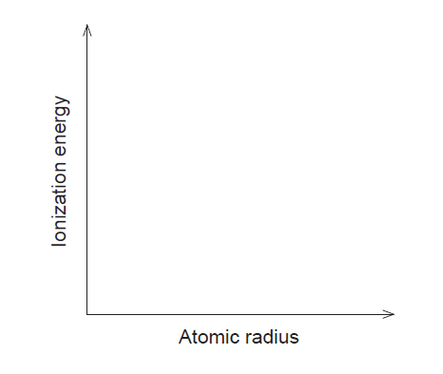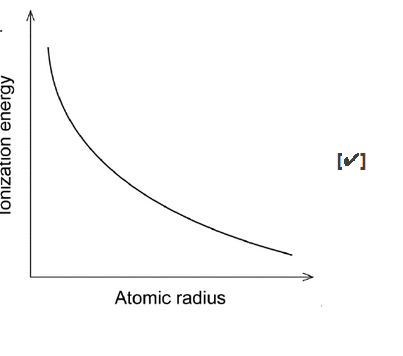Question
Physical properties of elements vary according to atomic number. Sections } 6 \text { to } 9 \text { of the data booklet list some of these properties.

a. Deduce, giving a reason, the group of elements in the periodic table most likely to undergo sublimation.
b(i)Describe the density trend across periods 4 and 5 of the periodic table.

b(ii)Suggest, with a reason, whether the lanthanoids or actinoids of the f-block would have the higher density.
$\mathrm{b}$ (iiifompare the ease of oxidation of s-block and d-block metals to their melting points and densities. Use section 25 of the data booklet.
$\mathrm{b}$ (ivsketch how the first ionization energies of elements vary with their atomic radius.

▶️Answer/Explanation
Markscheme
a. group $18 /$ noble gases [ $\checkmark$ ]
smallest difference between melting and boiling points
OR
weakest intermolecular forces «in that period» $[\boldsymbol{V}]$
Note: Accept “group 17/halogens”.
b(i)density increases «to a maximum in the transition elements» AND then decreases [ $\boldsymbol{C}]$
$\mathrm{b}(\mathrm{iipctinoids}$ AND density increases down all groups «due to large increase in atomic mass for small increase in atomic volume»
$O R$
actinoids AND «much» greater atomic mass with similar type of bonding
OR
actinoids $A N D$ density «of actinoids» atomic number 90 to 95 is greater than corresponding lanthanoids [ $\boldsymbol{C}$ ]
Note: Accept “actinoids AND on graph actinoids have «much» greater density than lanthanoids”.
b(iiiAlternative 1:
«metals with» low densities oxidize easier $[\boldsymbol{V}]$
«metals with» low melting points oxidize easier $[\boldsymbol{\sim}]$
Alternative 2:
in s-block «metals with» high densities oxidize easier
OR
in s-block «metals with» low melting points oxidize easier $[\boldsymbol{V}]$
in d-block «metals with» low densities oxidize easier
OR
in d-block «metals with» low melting points oxidize easier $[\boldsymbol{\sim}]$
Note: Award [1 max] for “s-block metals more easily oxidized” OR “s-block metals have lower melting points” OR “s-block metals have lower densities”.
Accept “have greater activity” for “oxidize easier”.

Note: Accept any negative sloping line.
Question
Iron may be extracted from an ore containing Fe2O3 in a blast furnace by reaction with coke, limestone and air. Aluminium is obtained by electrolysis of an ore containing Al2O3.
State the overall redox equation when carbon monoxide reduces Fe2O3 to Fe.
Predict the magnetic properties of Fe2O3 and Al2O3 in terms of the electron structure of the metal ion, giving your reasons.
Fe2O3:
Al2O3
Molten alumina, Al2O3(l), was electrolysed by passing 2.00×106 C through the cell. Calculate the mass of aluminium produced, using sections 2 and 6 of the data booklet.
▶️Answer/Explanation
Markscheme
Fe2O3 (s) + 3CO (g) → 2Fe (l) + 3CO2 (g)
Fe2O3:
paramagnetic
AND
unpaired electrons present «so magnetic moments do not cancel out»
Al2O3:
diamagnetic
AND
no unpaired electrons/all electrons are paired «so magnetic moments cancel out»
Award [1 max] for “Fe2O3 paramagnetic AND Al2O3 diamagnetic”.
Award [1 max] for “Fe2O3 unpaired electrons present AND Al2O3 no unpaired electrons/all electrons are paired”.
Award [1 max] for “Magnetic moments do not cancel out in Fe2O3 but do in Al2O3”.
Unpaired and paired electrons may also be conveyed by orbital diagrams for the respective ions.
\(n\left( {\rm{e}} \right) = \frac{{2.00 \times {{10}^6}}}{{96500}}/20.7 \ll {\rm{mol}} \gg \)
OR
n(Al)=\(\frac{1}{3}\)n(e)/6.91«mol»
m(Al)=«6.91×26.98=»186«g»
Award [2] for correct final answer for any value within the range 186–189 «g».
Question
Students were asked to investigate how a change in concentration of hydrochloric acid, HCl, affects the initial rate of its reaction with marble chips, CaCO3.
They decided to measure how long the reaction took to complete when similar chips were added to 50.0 cm3 of 1.00 mol dm−3 acid and 50.0 cm3 of 2.00 mol dm−3 acid.
Two methods were proposed:
(1) using small chips, keeping the acid in excess, and recording the time taken for the solid to disappear
(2) using large chips, keeping the marble in excess, and recording the time taken for bubbles to stop forming.
A group recorded the following results with 1.00 mol dm−3 hydrochloric acid:

Annotate the balanced equation below with state symbols.
CaCO3(__) + 2HCl(__) → CaCl2(__) + CO2(__) + H2O(__)
Neither method actually gives the initial rate. Outline a method that would allow the initial rate to be determined.
Deduce, giving a reason, which of the two methods would be least affected by the chips not having exactly the same mass when used with the different concentrations of acid.
State a factor, that has a significant effect on reaction rate, which could vary between marble chips of exactly the same mass.
Justify why it is inappropriate to record the uncertainty of the mean as ±0.01 s.
If doubling the concentration doubles the reaction rate, suggest the mean time you would expect for the reaction with 2.00 mol dm−3 hydrochloric acid.
Another student, working alone, always dropped the marble chips into the acid and then picked up the stopwatch to start it. State, giving a reason, whether this introduced a random or systematic error.
▶️Answer/Explanation
Markscheme
CaCO3(s) + 2HCl(aq) → CaCl2(aq) + CO2(g) + H2O(l)
Accept “CO2(aq)”.
[1 mark]
measure the volume of gas at different times «plot a graph and extrapolate»
OR
measure the mass of the reaction mixture at different times «plot a graph and extrapolate»
Accept other techniques that yield data which can be plotted and extrapolated.
[1 mark]
method 2 AND marble is in excess «so a little extra has little effect»
OR
large chips AND marble is in excess «so a little extra has little effect»
OR
method 2 AND HCl is limiting reagent «so a little extra marble has little effect»
OR
large chips AND HCl is limiting reagent «so a little extra marble has little effect»
Accept, as a reason, that “as the mass is greater the percentage variation will be lower”.
[1 mark]
surface area
OR
purity «of the marble»
Accept “shape of the chip”.
[1 mark]
variation of individual values is much greater «than this uncertainty»
OR
«uncertainty» does not take into account «student» reaction time
[1 mark]
«\(\frac{{121.96{\text{ s}}}}{2}\) = 60.98 s» = 61 «s»
[1 mark]
systematic AND always makes the time shorter «than the actual value»
OR
systematic AND it is an error in the method used «not an individual measurement»
OR
systematic AND more repetitions would not reduce the error
Accept, as reason, “it always affects the value in the same direction” OR “the error is consistent”.
[1 mark]
